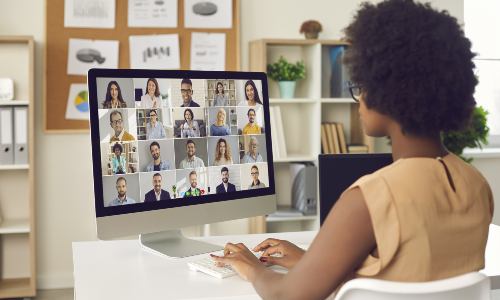As a result of the ongoing COVID-19 pandemic, the last two years have delivered businesses and institutions a crash course in adjusting to rapid change, requiring repeated alterations to work schedules, events, meetings, internal and external communications and training for employees or students. The solution to these changes centers on the ability of companies, schools, governments and other entities to leverage modern communications technologies in their offices and buildings to turn existing spaces into hybrid-flexible (HyFlex) rooms that provide everything needed for both in-person and remote attendance.
As worker responsibilities and training and education methods increasingly rely on virtual collaboration platforms, resimercial and commercial integrators have an opportunity to show organizations of all kinds how a HyFlex room can maximize productivity and ensure readiness to adapt to changing needs.
Virtual Meets Physical
There are a variety of situations today that can disrupt or dissuade organizations from holding in-person meetings, lectures or events. Even when the stars align and in-person meetings are held, it’s likely that some participants can’t be there or for any number of reasons can only attend through a virtual collaboration platform. This phenomenon isn’t exactly new, but the tools and technologies used to solve it are.
Video and audio capture technologies have advanced rapidly in recent years, with manufacturers constantly striving to improve resolution, compatibility, ease of use and special features. At the same time, some providers have focused on developing IP-based audio and video systems that can be implemented with minimal construction, wiring or intrusion into a room’s aesthetic.
HyFlex rooms combine these concepts, using multiple cameras and microphones in conjunction with digital displays and speaker systems to provide spaces that can be used for remote collaboration just as easily as for in-person needs. A typical HyFlex room has at least two cameras, with one focused on the presenter and the other capturing the entire room or the audience, depending on the size and layout. An important feature of these rooms is that they are kept free of boxy equipment and visible cabling that can limit how the room is used.
Keep It Simple, But Powerful
Integrators have no shortage of options when selecting products for HyFlex rooms. Manufacturers now offer everything from tabletop microphones and stationary cameras to beamforming microphone arrays designed to blend in with ceiling tiles and 4K PTZ cameras that use AI to keep the current talker in the frame as they move. Some spaces require multiple microphones or more than two cameras to ensure full capture coverage and provide remote attendees the same clarity and legibility as people in the room.
In addition to the microphones, cameras, digital displays and speakers, digital signal processors (DSPs) play a vital role in a professional-grade HyFlex solution. In rooms where ambient noise, echoes and other audio distractions are a concern, DSPs are used to provide acoustic echo cancellation, noise cancellation and feedback control, which all improve audio clarity.
The sophistication and price of components vary depending on the needs and size of the room being outfitted, but every system must deliver seamless compatibility with all other components and services as well as any future add-ons. This helps ensure the system is easy for staff to set up and use without training or assistance from IT professionals.
A positive user experience is essential to maximizing the value of a HyFlex room, because a room with lots of technology that is difficult to use simply won’t be used that much, and can even create resentment among workers who are forced to fumble through complicated procedures or unreliable equipment. In rooms designed for BYOD functionality, the connection and setup must be as painless as possible, regardless of the device or collaboration platform being used.
Special Features Make The Room
Maintenance can be simplified as well since a lower total number of components generally equates to fewer service calls and less opportunity for compatibility issues.
The difference between a five-year-old meeting room AV system and a true HyFlex solution can be significant. The latest camera systems, for instance, offer automatic multi-camera switching and focusing based on who is currently speaking, which can help create more immersive sessions and allow educators to focus on the topic at hand instead of troubleshooting their equipment.
The same goes for beamforming microphone arrays, which automatically detect the direction of the main noise source and aim multiple internal microphones at it to maximize volume and clarity while minimizing extraneous pickup.
Advanced microphone solutions may even offer on-board multi-channel amplifiers and advanced signal processing that can make installation of speakers and peripherals simpler, faster and more profitable. Maintenance can be simplified as well since a lower total number of components generally equates to fewer service calls and less opportunity for compatibility issues.
Institutions with internal IT or AV staff may consider integrating with a cloud-based AV management software platform, which enables remote system control and access. This further streamlines daily operations by allowing IT or AV staff to instantly view the status of all equipment and immediately respond to any needs, and many issues can be resolved remotely through the software.
The Future is Flexible
Using the latest audio and video capture technologies, HyFlex rooms provide organizations the ability to quickly adapt to changing circumstances and avoid disruptions to operations. Whether it’s a professor giving a lecture, a manager hosting an international conference call or a local government leading a training session for new staff, it’s vital that today’s leaders be able to conduct communications regardless of participants’ locations.
The ‘new normal’ of remote collaboration presents a major opportunity for integrators to recommend these solutions to both new and existing clients. As the available tools continue to advance, it’s up to us, the professionals, to ensure each system delivers maximum usability and flexibility for users while remaining compatible with new protocols, peripherals and software.
The Future is Flexible, and we are the ones who will build it!
Zee Hakimoglu is the President and CEO of communication device company ClearOne.







